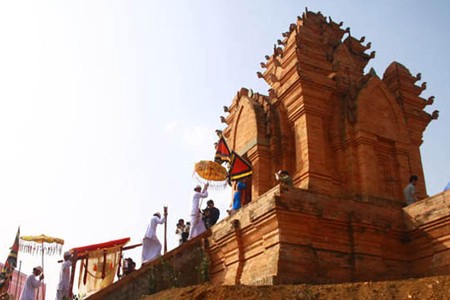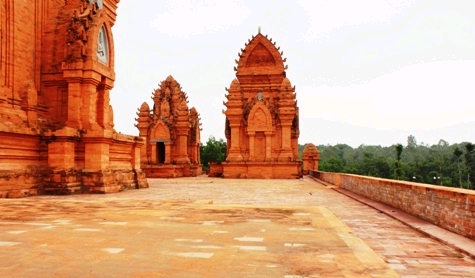(VOVworld)- Vietnam’s first ever Cham temple tower built by contemporary architects and artisans has opened in Hanoi as part of Vietnam’s Cultural Heritage Day. The Cham tower’s inauguration ceremony featured traditional ceremonies organized by Cham people. This was an opportunity to promote the uniqueness of Cham culture and strengthen exchanges between ethnic minority groups in Vietnam.
The Vietnamese Ethnic Cultural and Tourism Village in Dong Mo, Son Tay on the outskirts of Hanoi has become a venue for diverse cultural events. Cultural traditions of Vietnam’s 54 ethnic minority groups are recreated in the village which contains examples of the traditional houses of the Thai, Tay, Nung, Ba Na and E De ethnic groups. The village reflects the efforts of the Ministry of Culture, Sports and Tourism and the Management Board of the village to promote the culture and solidarity of ethnic minorities. The Cham tower complex consists of Poklong Garai temple towers characteristic of the central province of Ninh Thuan. The central tower, gate towers and fire towers of the complex are modeled after historical relics. Su Van Ngoc, a Cham culture researcher says: “Located on a hill, the three towers are faithful replicas. The central Kalan tower built with a solid mountain shaped structure is dedicated to King Po Klong Garai. Inside the tower, there’s a small space big enough to contain symbolic offerings representing aspirations of the Cham people. Cham people always build this tower on a hill, far from the village and its secular life. So the location of the tower in this village reflects Cham beliefs”.
 |
 |
The construction of the Cham tower took 4 years following the manual techniques of the Cham people. Cham painters, sculptors, engineers and artisans from Ninh Thuan province participated in the construction. Each tower is a work of art constructed of polished bricks assembled and connected by vegetable oil. Each statue and relief carving in the tower is an intricate work of sophisticated complexity.
The 160,000 Cham people living in Vietnam’s central and southern regions have preserved their unique culture which can be seen in architectural works, rituals and various genres of arts. The construction of a Cham tower in the Vietnam Cultural Village demonstrates Vietnam’s commitment to preserving its cultural heritage. Lam Van Khang, Deputy head of the Management Board of the Vietnamese Ethic Culture and Tourism Village says: “The tower is a cultural highlight in Hanoi and a venue for Cham ethnic minority people to practice their belief”.
The tower complex is now the site of a gate opening ceremony, a Ka te festival, and exhibitions of Cham work tools and costumes.
To Tuan